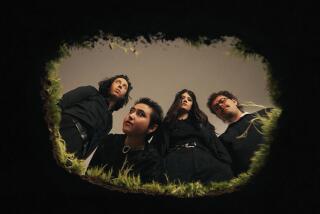Meet the Beasties--Again
- Share via
When the Beastie Boys emerged from suburban Long Island a dozen years ago, it was widely assumed that the trio would soon go the way of stone-washed jeans, Molly Ringwald and other short-lived phenomena from the much-maligned ‘80s.
A snotty, brash and sophomoric free-for-all that combined cheesy drum-machine beats, Led Zeppelin samples and the trio’s whiny rants, the group’s debut album, “Licensed to Ill,” sold bucketloads of albums, primarily to pizza-faced mall rats.
Today, the Beasties’ five studio albums map the progress of a band whose inventiveness and ambition have turned the trio into highly respected studio alchemists. They have become musical standard-bearers for a generation of rock artists.
“For kids of my generation, the Beasties are like the Beatles” says Sean Lennon, whose debut album, “Into the Sun,” was released this year on the Beastie Boys’ Grand Royal label. “They started off as this band with not really thoughtful music, and they evolved into revolutionizing the whole industry, making the most bizarre, eclectic records to hit the mainstream--kind of like what the Beatles and the Beach Boys had done in the ‘60s.”
Indeed, it’s hard to imagine hip-hop/pop artists such as Beck, Soul Coughing and Sugar Ray without them.
Although the Beasties (who play three Southland arena concerts next week) weren’t the first hip-hop group to connect with white audiences--Run-DMC had already accomplished that with its 1985 album “King of Rock”--they were the first white hip-hop artists to do so.
When aspiring rockers such as Sugar Ray vocalist Mark McGrath bought the Beasties’ early albums, they were not only smitten by the music but also came to identify with the band’s bratty white kid persona.
“The Beasties took hip-hop to the suburbs,” says McGrath. “For ‘80s kids like me, ‘Licensed to Ill’ is the equivalent of the Sex Pistols’ ‘Never Mind the Bollocks . . . .’ It got me into different music, and broke down racial barriers by combining hip-hop with elements of rock. Everyone from Limp Bizkit to Black Eyed Peas owes a huge debt to them.”
Because the Beastie Boys have always acknowledged both rock and hip-hop artists as forebears--and have made music that straddles both genres effectively--they are the most user-friendly hip-hop act for rock musicians to embrace. The Beasties’ music has always been a mongrelized blend that draws from the band’s encyclopedic grasp of rock and black music idioms.
They’ve also taken audacious leaps.
If “Licensed to Ill” branded the Beastie Boys as merry pranksters, their second album, “Paul’s Boutique,” merited attention as the handiwork of skilled studio craftsmen. It was a pop rarity: a hip-hop album that aspired to function as an organic whole, and not a scattershot collection of individual tracks.
In that sense, its conceptual reach had more in common with rock tradition than hip-hop.
The Beasties have also been in perfect tune with the prevailing zeitgeist. Their 1992 album, “Check Your Head,” was released right around the time that pop-culture vultures began to favor ‘70s kitsch in both music and fashion, which is something that had informed the Beasties’ aesthetic from the outset. “Check Your Head” upped the ante, however, with instrumental shadings, performed by the band using vintage gear, that resembled the music used in blaxploitation movies.
Like director Quentin Tarantino, the Beasties reclaimed the disposable artifacts and attitudes of their youth by making them hip again. “Paul’s Boutique,” “Check Your Head” and “Ill Communication” weren’t graphic dispatches from the urban front, but rather the sound of three couch potatoes obsessed with American junk culture.
“The Beastie Boys have never tried to be something they’re not,” says Vibe magazine editor at large Alan Light, who wrote the current Spin magazine cover story on the band. “They never tried to act black, and even at their most highbrow hip, they’ve always come off as a bit goofy.”
And the Beasties’ influence isn’t limited to America, or even England. For many international artists, the Beastie Boys are considered cultural emissaries for a particular brand of irreverent, polyglot street style.
“When I first heard the Beasties, I was living in Tokyo,” says Miho Hatori of the avant-pop band Cibo Matto. “I really got a very Lower East Side vibe from them. I thought, ‘Oh, this is what the New York scene is like, with white kids hanging out with black kids and Asian kids.’ It’s one of the reasons why I moved to New York.”
For many of the Beasties’ most ardent admirers, their appeal boils down to attitude, which has always been closer to the antic spirit of punk rock (the band started out as a hard-core band, after all) than to the cool reserve of hip-hop or the glum earnestness of so much contemporary pop.
“What I’ve liked about the Beastie Boys from Day One is that they’re a real band, like a rock band,” says guitarist Tim Armstrong of the punk band Rancid. “I love all of their hard-core stuff because it’s tumultuous, just totally off the hook and really wild, and they carry that attitude into everything they do. After the Ramones broke up, I would say that the Beastie Boys are the greatest American rock ‘n’ roll band.”
More to Read
The biggest entertainment stories
Get our big stories about Hollywood, film, television, music, arts, culture and more right in your inbox as soon as they publish.
You may occasionally receive promotional content from the Los Angeles Times.










